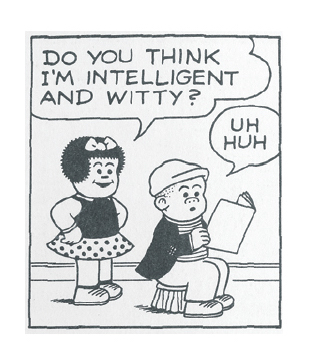Cartoonists have special games of their own, and one of the most entertaining is 5-Card Nancy, invented by comics theorist Scott McCloud. Its deck consists of a big pile of individual panels from the comic strip “Nancy”—preferably dating from the late ’40s and ’50s, when it hit a peak of deadpan inanity. Each player gets a hand of five panels, and one additional panel is placed on the table to begin the story. When it’s your turn, you can either 1) add one of your cards to continue the narrative (as in some kind of nightmarish fiction workshop, the other players vote on whether or not the card works; if not, you have to take it back), or 2) discard one of your cards and pick another one. As the game progresses, the story inevitably takes on head-spinning psychosexual overtones.The first player to run out of cards wins. This means, of course, that your competitors decide whether to let you play your final card; winning, as such, is not really the point of 5-Card Nancy.
It’s even less the point of 1,000 Blank White Cards, a doodling-intensive game invented by Nathan Mc- Quillan and played by three to six people. At the beginning, each player writes and draws on half a dozen or so blank cards to turn them into game cards. A game card includes a title (“Chairman Mao wins the poetry slam,” “Pneumogenesis,”“Soda is for wimps”), a drawing, and (more often than not) an instruction on how it affects play: awarding points or a penalty, adding rules, changing the meaning of other cards.
In stage 2, the playing deck is shuffled together from newly created cards, good cards from previous games, and some more blank cards (which can be turned into playable cards mid-game). Each player starts with five cards; on each turn, you play one card and take another, until they’re all gone. There may or may not be a nominal winner, depending on how stage 2 goes. The final stage is going through all the cards and deciding which ones are enough fun to keep around and add to the deck in future games; good players aim for this prestige rather than mere victory.
Another drawing game, Eat Poop You Cat!, is cursed with a name so embarrassing that it’s often referred to as I’pupiuqat or something similar. (A few people call it Paper Telephone, which is somehow not embarrassing enough.) Each player (nine or ten is a good number) gets a spiral-bound notebook and a pen.To play, you write a descriptive sentence—“The Beatles went diving for underwater Nazi gold,” say—on the notebook’s first page, then pass it to the right. You read the sentence written by the player who’s just handed you a notebook, turn the page, and draw a picture of what it described.
Then the notebooks are passed along again; this time, you look at the new notebook’s picture, turn the page, and write a sentence describing it. And so on, until the notebooks have gone all the way around, by which point “the log cabin was set ablaze with the pioneer family inside” will have become “the farmers screamed in terror after witnessing the horror of the giant singing rabbit.” Eat Poop You Cat! has the rare advantage that one or two inept artists—players who can’t draw a recognizable giant singing rabbit—actually make it more fun for everyone at the end, when the berserk chains of mutations are passed around again. “This notebook wins,” someone always says, meaning that everyone’s interpretive failures have won.





